Analysis of Ignition Characteristics and Influencing Factors of Combustible Fly Ash in Boiler Start-Up Stage Flue Gas
Abstract
:1. Introduction
2. Experimental System
3. Test Results and Analysis
3.1. Ignition Characteristics of Combustible Fly Ash in the Gas Stream
3.2. Influence of Combustible Gases in Flue Gas on Combustible Fly Ash Ignition
3.3. Effect of High-Temperature Side Flue Gas on Combustible Fly Ash Ignition
3.4. Influence of Combustible Fly Ash Composition on Ignition
4. Conclusions
- (1)
- The concentration of CO increased with an increase in the temperature of mixed smoke in the test section, which indicates that the volatile matter in combustible fly ash is continuously precipitated at a high temperature. When the temperature reached a certain value, the combustible fly ash started to ignite and burn. When alcohol was added as a combustible gas component, the flame formed in the test section was obviously brighter, which indicates that the combustible gas component also participates in ignition.
- (2)
- When the flue gas temperature in the test section was maintained at about 400 °C and the high-temperature flue gas temperature was raised from 650 °C to 813 °C, the combustible fly ash did not catch fire whether alcohol was added as a combustible gas component or not, which can eliminate the risk of secondary combustion and the explosion of combustible fly ash under this condition.
- (3)
- When the volatile matter content of combustible fly ash was 10~26.7%, the ignition point was 660~760 °C. The lower the volatile matter content of fly ash was, the higher the ignition point was. When alcohol was added as a combustible component of gas, the ignition point decreased by about 50 °C.
- (4)
- The oxygen concentrations in the high-temperature flue gas and low-temperature flue gas used in this experiment were much higher than those used in an actual power plant, so the critical ignition temperature of combustible fly ash obtained is relatively conservative, that is, it is lower than the critical ignition temperature in an actual power plant, which can provide a certain margin for the design and transformation of power plants in the future.
Author Contributions
Funding
Data Availability Statement
Acknowledgments
Conflicts of Interest
References
- Lin, G.; Yang, F.; Li, Z.; Zhao, X.; Tan, H. Characterization of particulate matter emissions from coal-fired units and their organic composition. Clean Coal Technol. 2022, 28, 145–151. [Google Scholar]
- Cao, Q.Q.; Xu, J.Y.; Lv, Y. Improvement and evaluation of coal-fired VOC sampling systems. Clean Coal Technol. 2022, 28, 86–92. [Google Scholar]
- Zhou, M.W.; Niu, G.P.; Jia, G.R.; Luo, Z.; Tan, Z.Q.; Yang, X.G. Numerical simulation of flue gas fly ash wear on the tail flue of boilers. Therm. Power Gener. 2019, 48, 62–67S. [Google Scholar]
- Dai, H.; Fan, J.; Sun, L.; Liu, D.; Yu, Y.; Wang, X.; Yu, X. Experimental study on the effect of initial temperature on the combustion and explosion characteristics of wet forming sulfur. China Saf. Prod. Sci. Technol. 2015, 11, 24–28. [Google Scholar]
- Dai, H.; Fan, J.; Liu, D.; Sun, L.; Sun, Y.; Yang, Z.; Yu, Y.; Zhou, Y. Experimental study on the effect of particle size on the combustion and explosion characteristics of sulfur. China Saf. Prod. Sci. Technol. 2015, 11, 120–124. [Google Scholar]
- Jiang, H.P.; Si, R.J.; Zhang, Y.S.; Li, R.Z. Effect of volatile fraction on the minimum ignition temperature of coal dust cloud. Coal Mine Saf. 2014, 45, 8–11. [Google Scholar]
- Song, Y.; Zhang, R.; Zhang, X.; Zhang, J.; Chen, N.; Xiao, K.; Zheng, L.; Chen, F. Experimental study on the ignition and combustion characteristics of poor quality coal blends. Boil. Technol. 2012, 43, 41–44. [Google Scholar]
- Zhao, D.; Jia, J.Z.; Qi, H.; Pan, J. Regression prediction of minimum ignition temperature of coal dust cloud by industrial analysis index. J. Liaoning Univ. Eng. Technol. (Nat. Sci. Ed.) 2019, 38, 234–240. [Google Scholar]
- Wang, J.F.; Meng, X.B.; Zhang, Y.S.; Chen, H.Y.; Liu, B. Experimental Study on the Ignition Sensitivity and Explosion Severity of Different Ranks of Coal Dust. Shock Vib. 2019, 2019, 2763907. [Google Scholar] [CrossRef]
- Chen, J.J.; Hu, S.Q.; Hu, L.S.; Ren, R.E.; Rong, J. Experimental study on the factors influencing the ignition temperature of coal dust cloud. Fire Sci. Technol. 2015, 34, 436–438. [Google Scholar]
- Wu, D.; Norman, F.; Verplaetsen, F.; Bulck, E. Experimental study on the minimum ignition temperature of coal dust clouds in oxy-fuel combustion atmospheres. J. Hazard. Mater. 2016, 307, 274–280. [Google Scholar] [CrossRef] [PubMed]
- Qiao, Y.; Zhang, L.; Binner, E.; Xu, M.; Li, C. An investigation of the causes of the difference in coal particle ignition temperature between combustion in air and in O2/CO2. Fuel 2010, 89, 3381–3387. [Google Scholar] [CrossRef]
- Liu, H.; Chen, H.; Zhang, X.; Hu, Y.; Fan, C. Effects of different factors on the minimum ignition temperature of the mixed dust cloud of coal and oil shale. J. Loss Prev. Process Ind. 2019, 62, 103977. [Google Scholar] [CrossRef]
- Deng, J.; Qu, J.; Wang, Q.; Xie, C. Experimental study on the minimum ignition temperature of bituminous coal dust cloud. Min. Saf. Environ. Prot. 2014, 41, 13–15. [Google Scholar]
- Mishra, D.P.; Azam, S. Experimental investigation on effects of particle size, dust concentration and dust-dispersion-air pressure on minimum ignition temperature and combustion process of coal dust clouds in a G-G furnace. Fuel 2018, 227, 424–433. [Google Scholar] [CrossRef]
- Jabbar, A.M.; Jafar, Z.; Behdad, M. Experimental investigation of the minimum auto-ignition temperature (MAIT) of the coal dust layer in a hot and humid environment. Fire Saf. J. 2016, 82, 12–22. [Google Scholar]
- Cao, W.; Huang, L.; Liang, J.; Niao, N.; Rao, N. Research on Characteristic Parameters of Coal-dust Explosion. Procedia Eng. 2012, 45, 442–447. [Google Scholar] [CrossRef]
- Liu, T.Q. Study on the variation of the minimum ignition temperature of coal dust clouds with different coal qualities. Ind. Min. Autom. 2019, 45, 6. [Google Scholar]
- Wang, Q.; Fang, F.; Li, Z. Fire characteristics analysis of four typical flammable bituminous coals. China Saf. Prod. Sci. Technol. 2020, 16, 89–95. [Google Scholar]
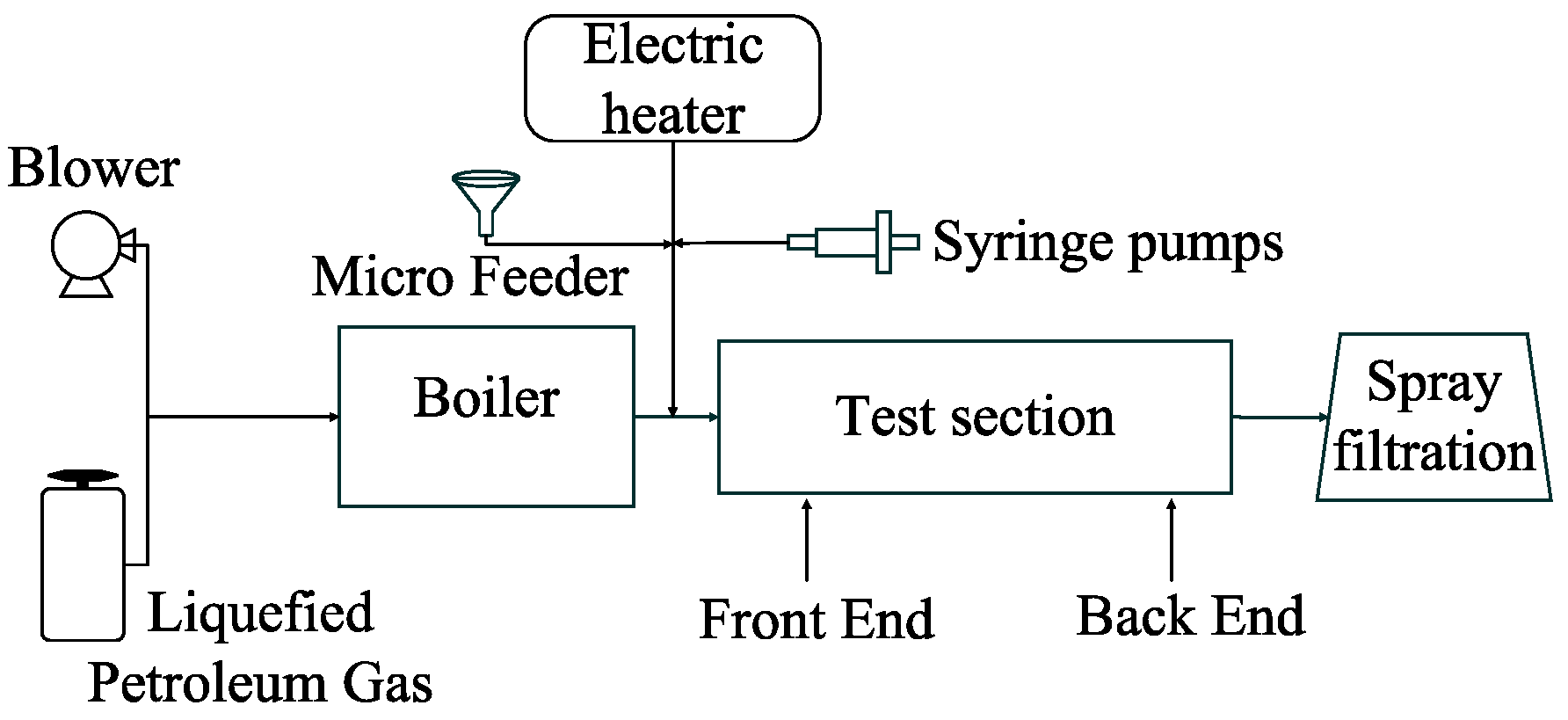
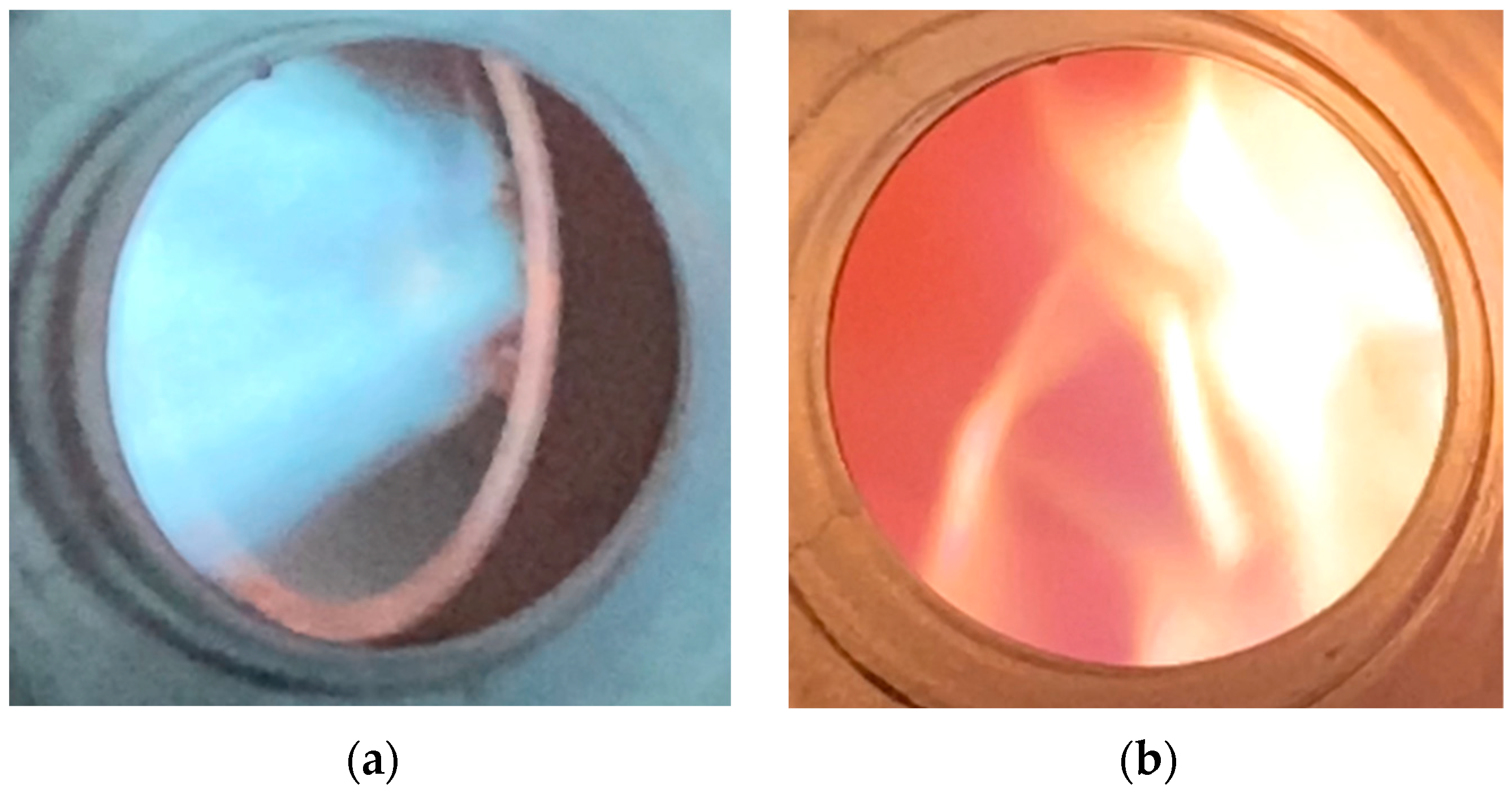



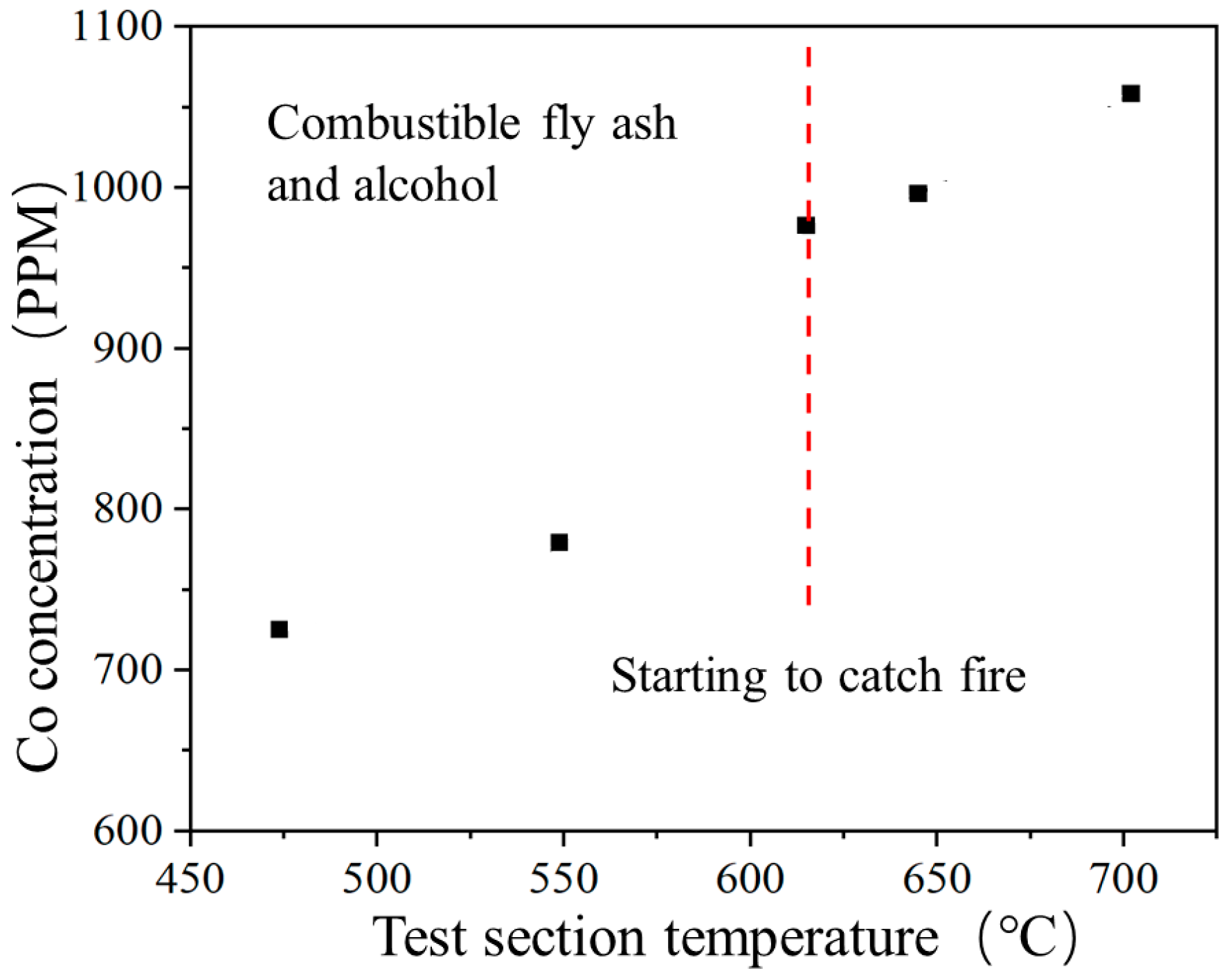
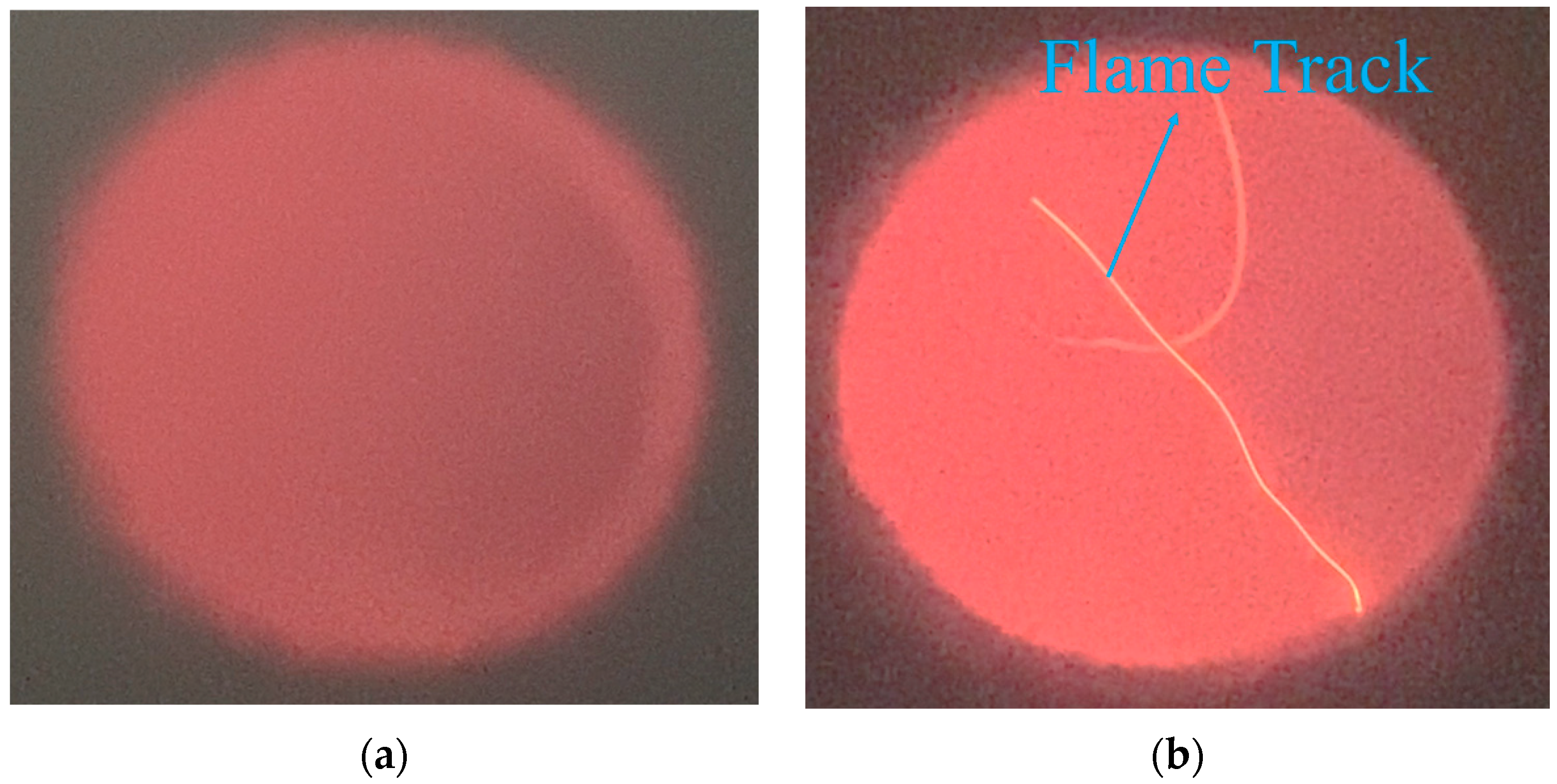
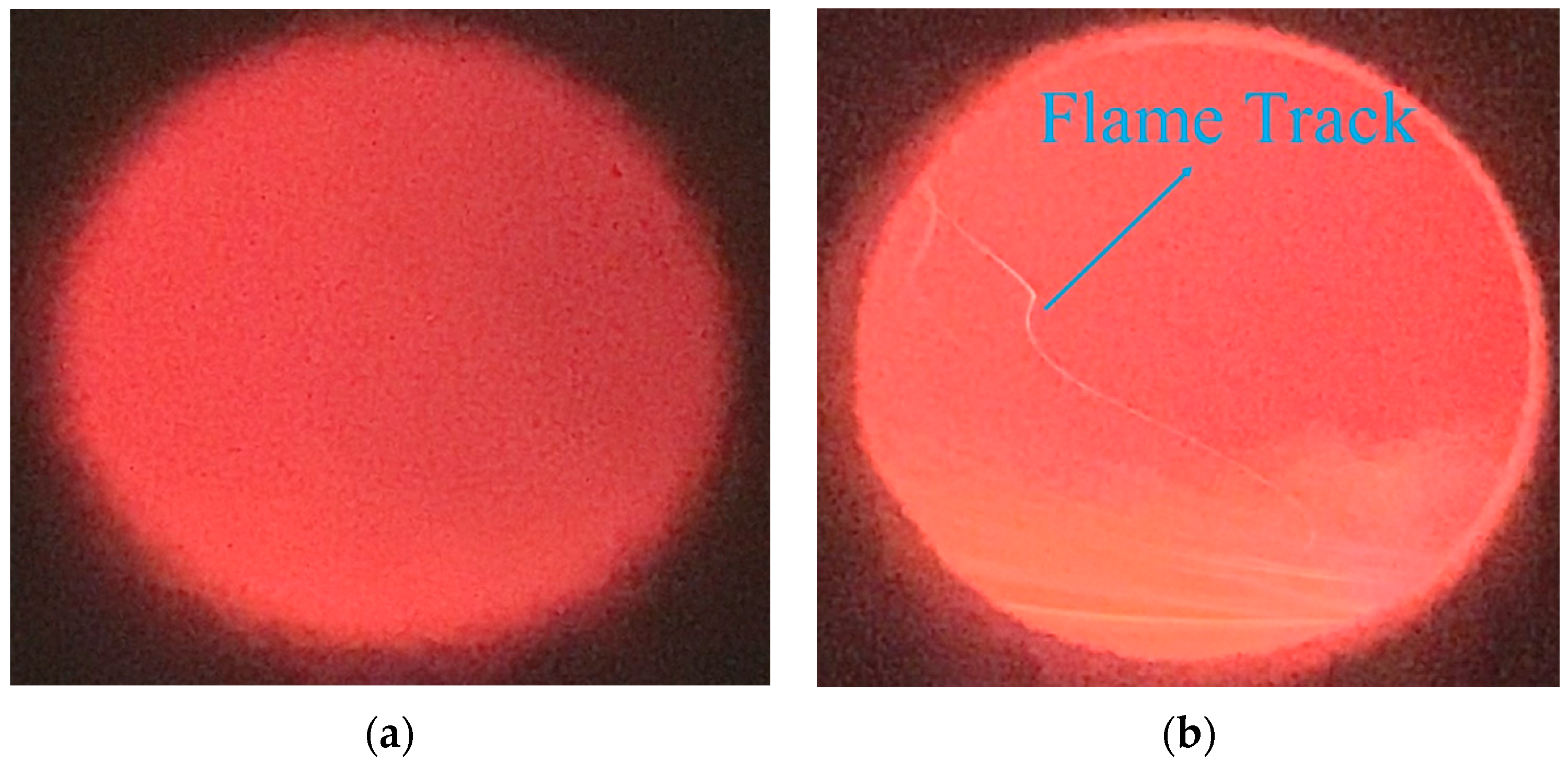
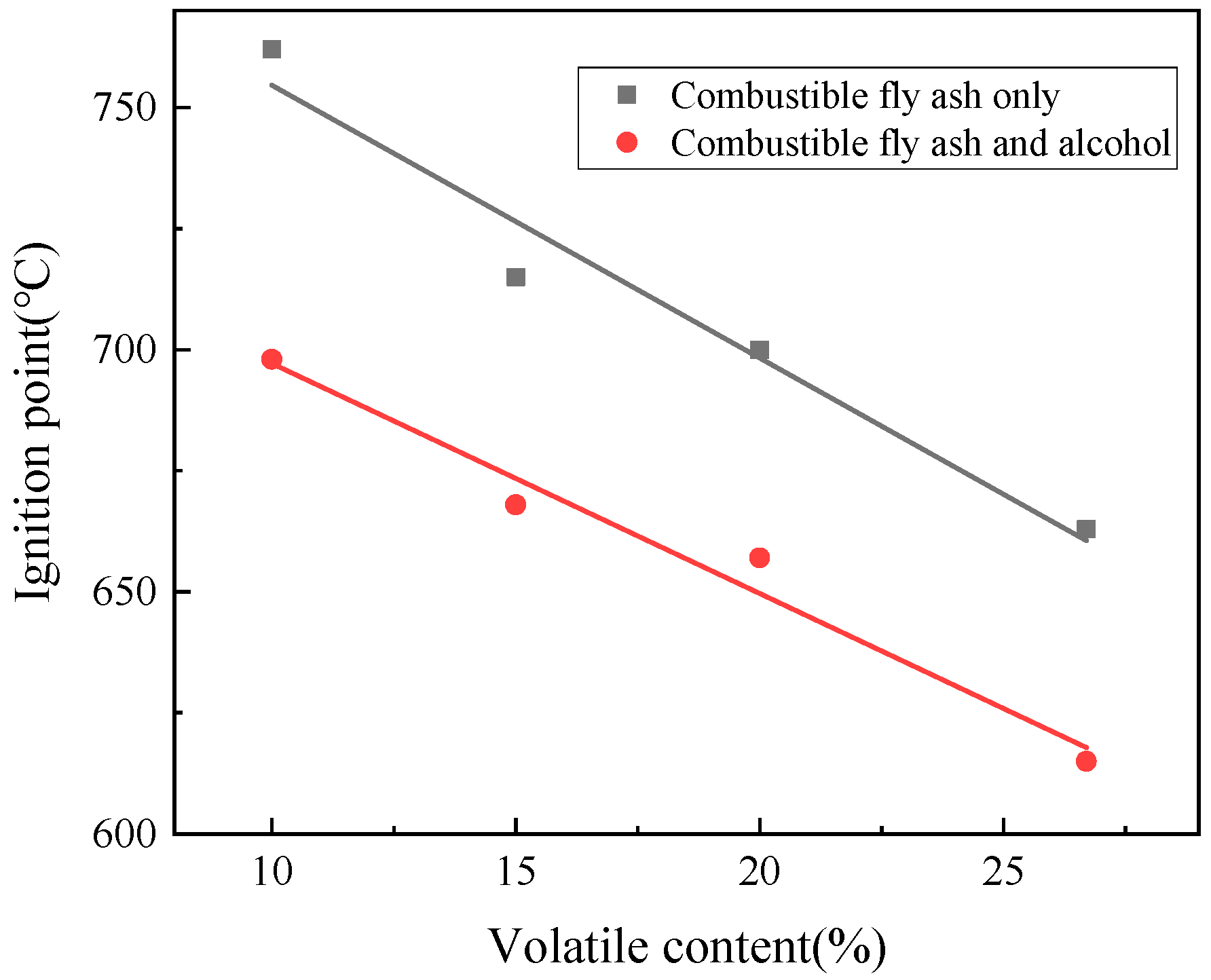
| Components | Ash | Moisture | Volatile Matter | Fixed Carbon |
|---|---|---|---|---|
| Unit | % | % | % | % |
| Sample 0 | 16.45 | 14.27 | 26.7 | 42.58 |
| Sample 1 | 18.43 | 0 | 20 | 61.57 |
| Sample 2 | 19.32 | 0 | 15 | 65.68 |
| Sample 3 | 21.9 | 0 | 10 | 68.1 |
| Components | O2 | CO | CO2 | NO | NO2 |
|---|---|---|---|---|---|
| Unit | % | ppm | % | ppm | ppm |
| Numerical | 14.1 | 25 | 4.8 | 32 | 2.5 |
| High-Temperature Flue Gas Temperature | Low-Temperature Flue Gas Temperature | Post-Mixing Temperature | CO Concentration at the Front of the Test Section | CO Concentration at the End of the Test Section | Whether It Is on Fire |
|---|---|---|---|---|---|
| (°C) | (°C) | (°C) | (ppm) | (ppm) | |
| 740 | 163 | 559 | 75 | 96 | No |
| 845 | 154 | 620 | 115 | 158 | No |
| 900 | 156 | 669 | 282 | 415 | No |
| 942 | 145 | 697 | 239 | 278 | Yes |
| Volatile Content of Combustible Fly Ash (%) | Alcohol Flow (mL/min) | Ignition Temperature (°C) | |
|---|---|---|---|
| only combustible fly ash | 26.7 | 0 | 663 |
| combustible fly ash and alcohol | 26.7 | 10 | 615 |
| High-Temperature Flue Gas Temperature | Low-Temperature Flue Gas Temperature | Post-Mixing Temperature | CO Concentration | Whether It Is on Fire |
|---|---|---|---|---|
| (°C) | (°C) | (°C) | (ppm) | |
| 649 | 105 | 422 | 80 | No |
| 709 | 105 | 440 | 79 | No |
| 754 | 117 | 368 | 14 | No |
| 813 | 141 | 435 | 37 | No |
| High-Temperature Flue Gas Temperature | Low-Temperature Flue Gas Temperature | Post-Mixing Temperature | CO Concentration | Whether It Is on Fire |
|---|---|---|---|---|
| (°C) | (°C) | (°C) | (ppm) | |
| 660 | 105 | 430 | 330 | No |
| 715 | 102 | 439 | 281 | No |
| 760 | 120 | 370 | 135 | No |
| 813 | 142 | 426 | 350 | No |
| Volatile Matter Content (%) | Only Combustible Fly Ash Ignition Point (°C) | Combustible Fly Ash and Alcohol Ignition Point (°C) |
|---|---|---|
| 26.7 | 663 | 615 |
| 20 | 700 | 657 |
| 15 | 715 | 668 |
| 10 | 762 | 698 |
Disclaimer/Publisher’s Note: The statements, opinions and data contained in all publications are solely those of the individual author(s) and contributor(s) and not of MDPI and/or the editor(s). MDPI and/or the editor(s) disclaim responsibility for any injury to people or property resulting from any ideas, methods, instructions or products referred to in the content. |
© 2023 by the authors. Licensee MDPI, Basel, Switzerland. This article is an open access article distributed under the terms and conditions of the Creative Commons Attribution (CC BY) license (https://creativecommons.org/licenses/by/4.0/).
Share and Cite
He, J.; Guo, D.; Zhang, J.; Yu, P.; Shen, M.; Zhang, G. Analysis of Ignition Characteristics and Influencing Factors of Combustible Fly Ash in Boiler Start-Up Stage Flue Gas. Energies 2023, 16, 6114. https://doi.org/10.3390/en16176114
He J, Guo D, Zhang J, Yu P, Shen M, Zhang G. Analysis of Ignition Characteristics and Influencing Factors of Combustible Fly Ash in Boiler Start-Up Stage Flue Gas. Energies. 2023; 16(17):6114. https://doi.org/10.3390/en16176114
Chicago/Turabian StyleHe, Jianle, Dong Guo, Jianli Zhang, Pengfeng Yu, Mengsong Shen, and Guangxue Zhang. 2023. "Analysis of Ignition Characteristics and Influencing Factors of Combustible Fly Ash in Boiler Start-Up Stage Flue Gas" Energies 16, no. 17: 6114. https://doi.org/10.3390/en16176114





